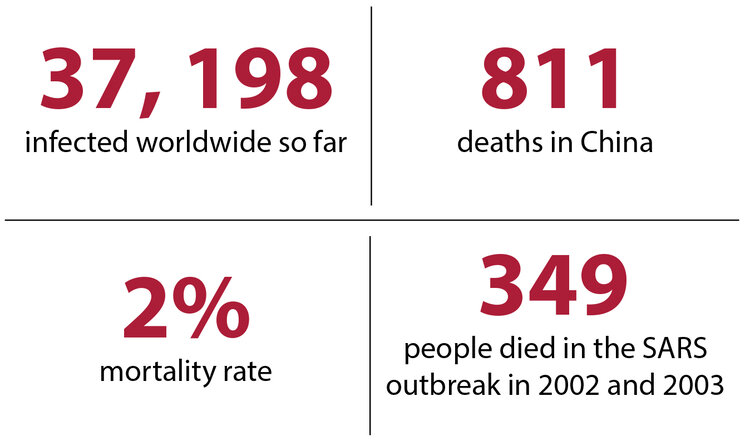
Written by Mitali Shukla
Twelve confirmed cases of the novel Coronavirus are present in the United States, six of which are in California
On Dec. 31, 2019, China announced the outbreak of Coronavirus, an upper respiratory illness, in the city of Wuhan. As of Feb. 9, China’s Health Commission confirmed that 37,198 people have been infected so far, according to the New York Times.
There has been one confirmed case of the novel Coronavirus in Orange County, but the patient was released from the hospital in good health Feb. 5. The risk for infection in Orange County is low, according to the Orange Health Care Agency. As of Feb. 9, there are 12 confirmed cases in the United States, 6 of which are in California.
Jennifer Totonchy, an assistant professor in Chapman’s School of Pharmacy who specializes in immunology and virology, said it would be ignorant for Americans to believe the virus would not have spread to the United States. She also predicts that more cases will pop up over the next few weeks. “Right now, they’re reporting a two percent mortality rate which is much higher than the flu,” Totonchy said. “But there’s also a lot of suspicion in the scientific community that there are a lot of cases not being reported because there are people having very mild illnesses. It could be that there are a lot more cases than we think which would make the mortality percent go down.”
As of Feb. 9, only two percent of those infected have died, according to the New York Times. The total number of deaths in China reached 811.
Dr. Gary Fong, also a professor in Chapman’s School of Pharmacy, said instead that Americans should not be paranoid about Coronavirus and instead focus on avoiding the flu.
“Paranoia is not where we should be in terms of this virus at this point. 98 percent of these cases are in China and 80 percent of those are from one region in China,” he said. “If you look at flu statistics in the United States, conservative estimates average at 20 million cases of the flu in the US and well over 10,000 deaths. To the everyday American, the flu is something that’s much more relevant to us.”
Patricia Martinez, a junior screenwriting major, witnessed fear from other American college students while studying abroad in Florence, Italy, where there are three confirmed cases of the novel Coronavirus.
“The first two cases were diagnosed in people staying at the hotel in Rome we were staying at,” she said. “Our program decided that the best option would be to stay at the hotel because Italian authorities assured them the situation was handled.”
Martinez said their dean held a meeting to confirm if any of the students had contact with the two Chinese guests that had been quarantined.
“One girl, not a Chapman student, shot her hand up and said she had and that ‘There were so many of them during our tour at the Vatican!” Martinez said. “The next day we had a tour at the Colosseum and I was standing next to a group of girls who saw an East Asian tour group and ran in the opposite direction saying they were going to get the Coronavirus.”
When asked about the racism and xenophobia surrounding the public reaction to the virus, Fong said that viruses such as these often trigger these types of fear in people.
“Considering the number of Asian Americans we have in the country, the xenophobia is taking it too far,” he said. “This virus does not infect based on race. Just because it started in China doesn’t mean it can only infect Chinese people.”
The Coronavirus, a family of viruses that primarily infects bats, cats, and birds. However, seven types of the virus infect humans: including, but not limited to, the novel Coronavirus (nCov), SARS and MERS, according to Vox. Fong and Totonchy both said that the number of confirmed cases don’t represent everyone who has the virus because some people have not been diagnosed.
“The virus has showed us that it spreads pretty well; it’s infected significantly more people than SARS and MERS in the previous Coronavirus outbreaks,” Fong said. “That’s the concerning nature of this outbreak – its ability to spread.”
To prevent the spread of illnesses, Fong recommends that students get their flu vaccines and wash their hands frequently to slow the spread of germs.

